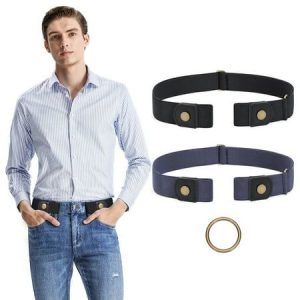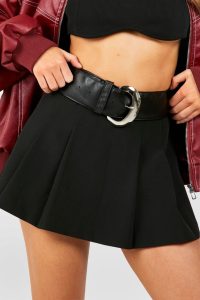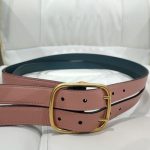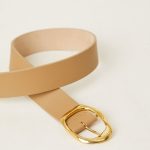The suit is a timeless garment, a staple in any man’s wardrobe. But when it comes to putting the finishing touches on a formal look, a question arises: is a belt always necessary?
The answer, like many things in fashion, is not a simple yes or no. Here’s a closer look at the role of belts in formal attire to help you decide what’s right for you.
Belt or No Belt? Weighing the Pros and Cons
The Case for the Belt
-
Practicality: Belts serve a functional purpose. They help keep your suit pants in place, ensuring a clean and polished look throughout the day. This is especially important if your suit pants aren’t perfectly tailored.
-
Aesthetics: A well-chosen belt can add a touch of style to your outfit. It can complement your shoes and tie, creating a cohesive look.
-
Completeness: Empty belt loops can look unfinished. A belt ties the whole outfit together, making it look more polished.
The Case for the No-Belt Look
-
Clean Lines: A well-tailored suit with no belt creates a clean, streamlined look. This is particularly favored for formal occasions.
-
Comfort: Belts can sometimes dig into your waist. Ditching the belt can offer more comfort, especially for long events.
-
History Lesson: Traditionally, suits were designed without belt loops. Suspenders were often used to keep pants up. So, going beltless can be a nod to classic tailoring.
Making the Decision: Factors to Consider
Suit Style
-
Formal vs. Casual: Formal suits tend to look best with belts. However, you can often go beltless with a more casual suit.
-
Fabric and Tailoring: A well-tailored suit in a heavier fabric may drape better without a belt. Lighter fabrics or suits with a looser fit might benefit from a belt to cinch the waist.
Personal Style
-
Comfort: Consider how you feel in a belt. If you find them restrictive, go for the no-belt look.
-
Fashion Sense: Ultimately, the choice comes down to your personal style. Do you prefer a clean, modern look, or a more classic silhouette?
Belt Up or Ditch the Buckle? Tips for Both Looks
Going with a Belt
-
Material: Leather belts are the most classic choice. Choose a belt in a color that complements your shoes.
-
Width: Opt for a thin to medium-width belt. A wide belt can look too casual with a suit.
-
Buckle: Simple and sleek buckles are best for formal wear. Avoid anything too flashy or decorative.
Going Beltless
-
Tailoring: Ensure your suit pants are well-tailored for a proper fit without a belt.
-
Shirt: A tucked-in shirt with a clean line will help maintain a polished look.
-
Suspenders (Optional): Consider suspenders for a touch of vintage flair. Choose thin suspenders in a color that matches your trousers.
The decision of whether or not to wear a belt with your suit is a personal one. Consider the factors above and experiment with both looks to see what you feel most comfortable and confident in.

Suited Up and Looking Sharp: The Finishing Touches
Once you’ve decided on the belt situation, there are other ways to elevate your formal look:
-
Shoes: Leather dress shoes in a complementary color to your belt (if you’re wearing one) are a must. Polish them to a shine!
-
Socks: Dress socks should match your trousers or be a darker shade. Avoid novelty socks for a formal occasion.
-
Tie: A well-coordinated tie can add a pop of color or pattern to your outfit.
-
Pocket Square (Optional): A pocket square adds a touch of sophistication. Opt for a silk or cotton fabric in a color or pattern that complements your tie.
No matter what you decide about the belt, the most important element is to feel confident in your outfit. When you feel good in what you’re wearing, it shows. So pick the look that makes you feel sharp and assembled, and take on the day!
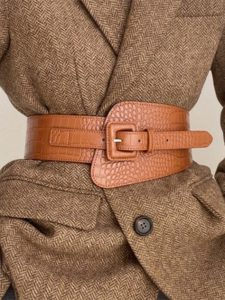
Stepping Up Your Suit Game: Beyond the Belt
While the belt is a key element, there are other ways to elevate your suit game:
-
Fit is King: A well-fitted suit is the foundation of any polished look. If your suit hangs right off you or feels too constricting, consider getting it tailored. A tailor can adjust the sleeves, pants, and waist for a perfect fit that flatters your body type.
-
Shoe Selection: The right shoes can make or break your outfit. Leather dress shoes in a classic style, like oxfords or derbys, will always complement a suit. Match the leather color to your belt (if you’re wearing one) for a cohesive look. Keep them polished!
-
Sock Harmony: When it comes to socks, there’s a simple rule: they should coordinate with your trousers or be a darker shade. Avoid novelty socks with cartoon characters or crazy patterns for a formal occasion. Opt for classic solids or subtle patterns.
-
The Power of the Tie: A well-chosen tie can add personality and polish to your suit. Play with color or pattern, but be sure the tie complements your shirt and suit. Thinner ties are generally considered more modern, while wider ties can lend a vintage vibe.
-
Pocket Square Flair (Optional): A pocket square adds a touch of sophistication and can tie your outfit together. Choose a fabric like silk or cotton in a color or pattern that complements your tie. There are different folding techniques you can try to add a personal touch. A simple puff fold is always a safe bet for a formal occasion.

Beyond the Basics
Formal wear offers opportunities to express your style beyond the essential elements. Consider these additional tips:
-
Cufflinks and Tie Clips: These can add a touch of personality and shine. Choose simple designs in metals that complement your watch and belt buckle.
-
Dress Watch: A classic watch elevates any outfit. Opt for a leather band for a formal look.
-
Coordinating Colors and Patterns: Play with color and pattern in your tie, pocket square, and socks, but ensure everything complements each other. Solid colors are always a safe option, but patterns can add visual interest if done correctly.
By following these tips and experimenting with different looks, you can develop your own signature style in the world of formal wear.

